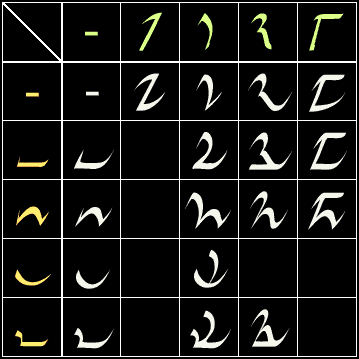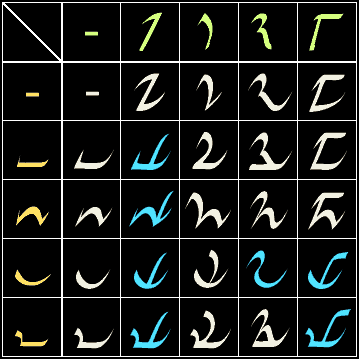![]()
![]()
You probably know the symbols above. It is the D'ni alphabet. However, the order of the characters is different from somewhere else. We would of course arrange the letters in a way that is, for us, easy to remember: a, ah, ay, b, ch, d, ...
The above list of characters is the correct D'ni alphabet. The D'ni obviously had a different order with their letters - you can see them arranged this way in the School Room of Riven. (The eleven characters to the right stand separated for a special reason, they are only altered versions of the 'standard' version from the left list. Originally, each would be next to the letter it is based on.) If you look at the characters carefully, you will recognize that the above order is absolutely logical: The D'ni letters consist of repeated parts (i.e. the first four) that are recombined with for different "bottom parts".
(Note. The following theory explains the system that stands behind these symbols. The reason to put them in exactly this order is something else. That's described in the section "Connections between letters and numbers".
The result is as follows:
- There are four parts that seem to be used as "top" of a character:
- There are four parts that make up the "bottom" of a character:
- Characters are combinations of a top part and a bottom part, including the possibility that a top part or a bottom part stands alone.
Therefore, there have to be 25 characters, because if you combine
5 'tops' (4 normal + 1x 'empty') with 5 'bottoms' (4 normal + 1x 'empty'),
you will get 25 combinations.
- These combinations would have to fit in a 5
by five grid.
You can easily see the letters as a combination of a top part (columns)
and a bottom part (rows).

This also leads to two more ideas:
a) There will only be 24 letters, because no top and no bottom
is no character.
b) Sometimes, the letters will look a bit different, as we
can see at the 'top only' characters in the first row.
We will have to accept little modifications at some letters. These
are left out in the grid, but if we try to assign each character to a cell
in the grid, the result will be this:

I think everyone can still see the 'roots' of the
characters even with the blue ones. It is a consequence of long use of
a language to modify characters to get a more easy way of writing them.
(Even if the language is not used, but constructed to be like a used one.)
Well, and if you now take eleven of these 24 characters and add them a
second time, this time with a little dot, you will receive - the complete
list of the 35 D'ni characters.
Note: The images on this site were produced using the Freeware Truetype "D'ni Font" by Andy Moriarity (http://web.triton.net/andym/dfont.htm). This font is very good ad contains also the numerals. It has been checked by Richard A. Watson from Cyan, so it is at least semi-official.
Attention: This page has been revised in July 1999. The order of the letters is now the same as the original order of the D'ni alphabet. Two rows of the grid had to be switched because of new discoveries about the origin of the letters.
If you found this page interesting, please look also at the section "Connections between letters and numbers"
which describes the possible origin of the letters and the relation to
the well-known D'ni number symbols following the ideas of Christopher Gilson
and me.